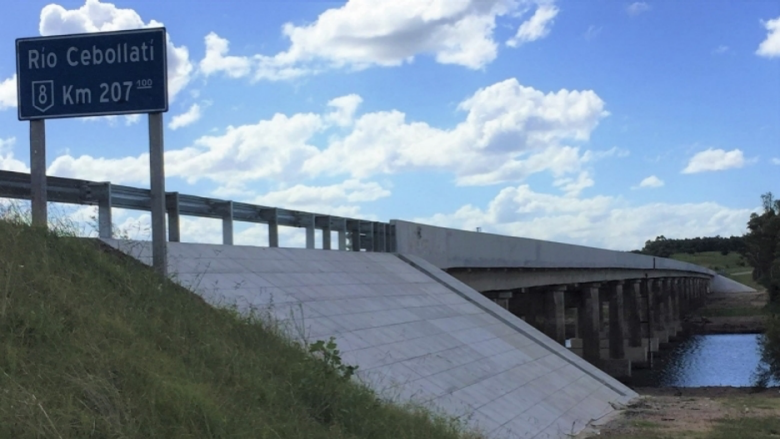Challenge
Uruguay’s national highway network suffered from tornadoes, heavy rainfall, droughts, and heat waves among just some of the violent weather events that have hit Uruguay in recent years. These are not isolated phenomena. Data from the Uruguayan government show a significant increase in rainfall since 2001. These events, combined with years of underinvestment, led Uruguay’s road infrastructure to deteriorate, with barely 35 percent of the 8,900 kilometers (km) of national roads in good or very good condition in 2012. The poor shape of the roads drove up logistic costs, in a country that relies heavily on roads for its exports and its internal connectivity.
Approach.
The Uruguay Road Rehabilitation and Maintenance Program (Program) was designed to address these challenges in a holistic way. A Program-for-Results (PforR) was chosen as lending instrument, a first in Latin America and the Caribbean, focusing on disbursement against results achieved instead of inputs. Disbursement indicators covered several key dimensions of the Program including: the number of kilometers of highway rehabilitated, the number of kilometers of highways managed by performance-based contracts, the number of kilometers of highways with traffic safety improvements, as well as results achieved to improve the roads climate resilience (mapping of national network areas prone to flooding) or roadworks quality control.
Map: Uruguay’s national highway network, Ministerio de Transportes y Obras Públicas
Results
The Uruguay Road Rehabilitation and Maintenance Program achieved substantial results. From 2012 to 2019:
- 1,854 km of highways were rehabilitated, surpassing the target of 1,414 km; overall, Uruguay’s Ministry of Transport and Public Works (MTOP) rehabilitated an average of 250 km/year during the Program, compared to an average of 120 km/year before.
- 3,637 km of highways were managed under performance-based road maintenance contracts in 2019, surpassing the target of 3,000 km for that year. Performance-based management is a cost-effective road maintenance contractual arrangement.
- 310 km of highways benefitted from safety improvements, surpassing the target of 263 km;
In addition, the Program has made substantial progress in enhancing road sector management by institutional strengthening within the sector:
- Planning: MTOP’s planning capacity has been strengthened, particularly through the Montevideo seaport planning study and the national freight transport modeling;
- On engineering and technical aspects, the recategorization of the national road was key to define differentiated levels of road service, according to their level of traffic and safety characteristics. A pavement standardized technical solutions manual was adopted, for further cost-efficiency. A roadworks supervision manual contributed to improving the efficiency of works field supervision.
- Environmental compliance was strongly reinforced through the adoption of the Roadworks Environmental Manual. Roadworks environmental auditing has been streamlined and environmental data management improved.
- Social impacts management and safeguards have also been strengthened, with the adoption of a Manual of Expropriation Procedures and Social Management for MTOP and the establishment of MTOP’s Citizen Attention Center (CAC).
- Road safety audits have become a standard practice. MTOP set up a road safety management tool to prioritize and monitor road safety investments.
- On climate resilience, MTOP prepared a mapping of the climate-risk prone areas of Uruguay’s national road network and developed a methodology to assess bridge resilience to climate risks. This allows public policy decision-makers to think in the medium and long term, strategically plan how and where to invest, avoid unnecessary expenses, and generate infrastructure that is more resistant to climate impacts. These improvements generate concrete benefits: globally, a return of US$ 4 is expected for every dollar invested in resilience (an estimate of the 2019 World Bank report, Lifelines: the Resilient infrastructure opportunity).
Bank Group Contribution
The World Bank, through the International Bank for Reconstruction and Development (IBRD), supported the Uruguay Road Rehabilitation and Maintenance Program through two loans: the first, for US$66 million was approved in 2012, and an additional loan for US$70 million was approved in 2016 to scale-up program results.
Partners
The Uruguay Roads Rehabilitation and Maintenance Program was co-implemented by the Uruguay Ministry of Transport and Public Works (MTOP) and the Uruguay National Roads Corporation (CVU). IBRD loans were complemented by US$345 million co-financing from several international financing institutions, including the Inter-American Development Bank (IDB), the Development Bank of Latin American (CAF), the Fund for the Development of the Plate River basin (FONPLATA) and Fund for the Structural Convergence of Mercosur (FOCEM).
Moving Forward
The Program substantially improved road conditions in Uruguay; a considerable increase of funding to the road sector made this improvement possible. Moving forward, the main challenge will be to maintain an adequate level of funding to the road sector, so that quality can be maintained, if needed developed, and road safety improvements can be scaled up. In a context of limited fiscal resources, the expansion of user-pay tolling for highways should be explored.
Beneficiaries
Program beneficiaries include the thousands of people that use the national highways on a daily basis to go to work, school, markets or social services facilities. Highway improvements have also benefitted trade and exports, particularly agriculture exports, with more reliable roads and reduced logistics costs. In 2019, 247 firms exported almost US$7 billion in agricultural products, almost exclusively using road-based logistics.
